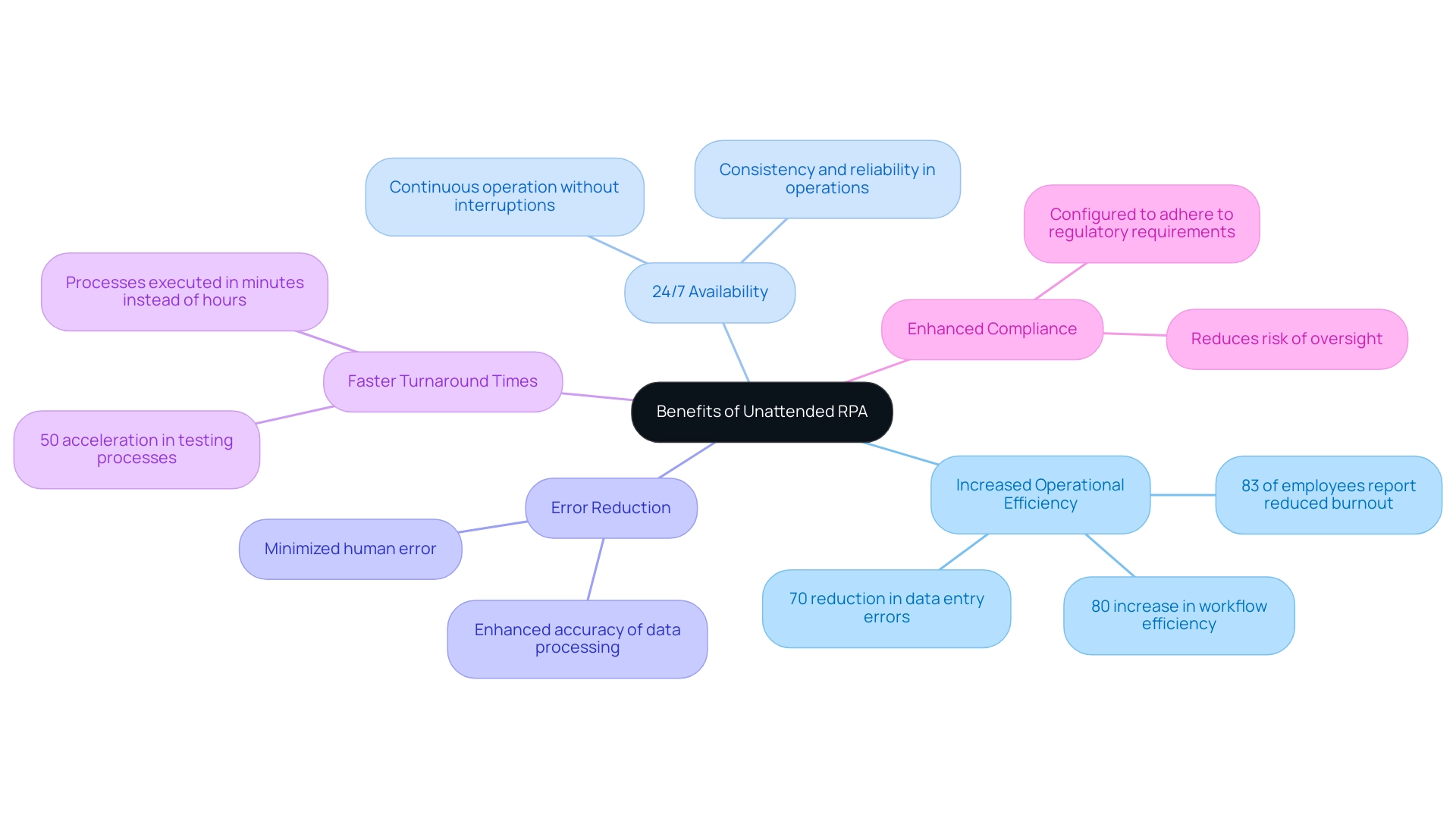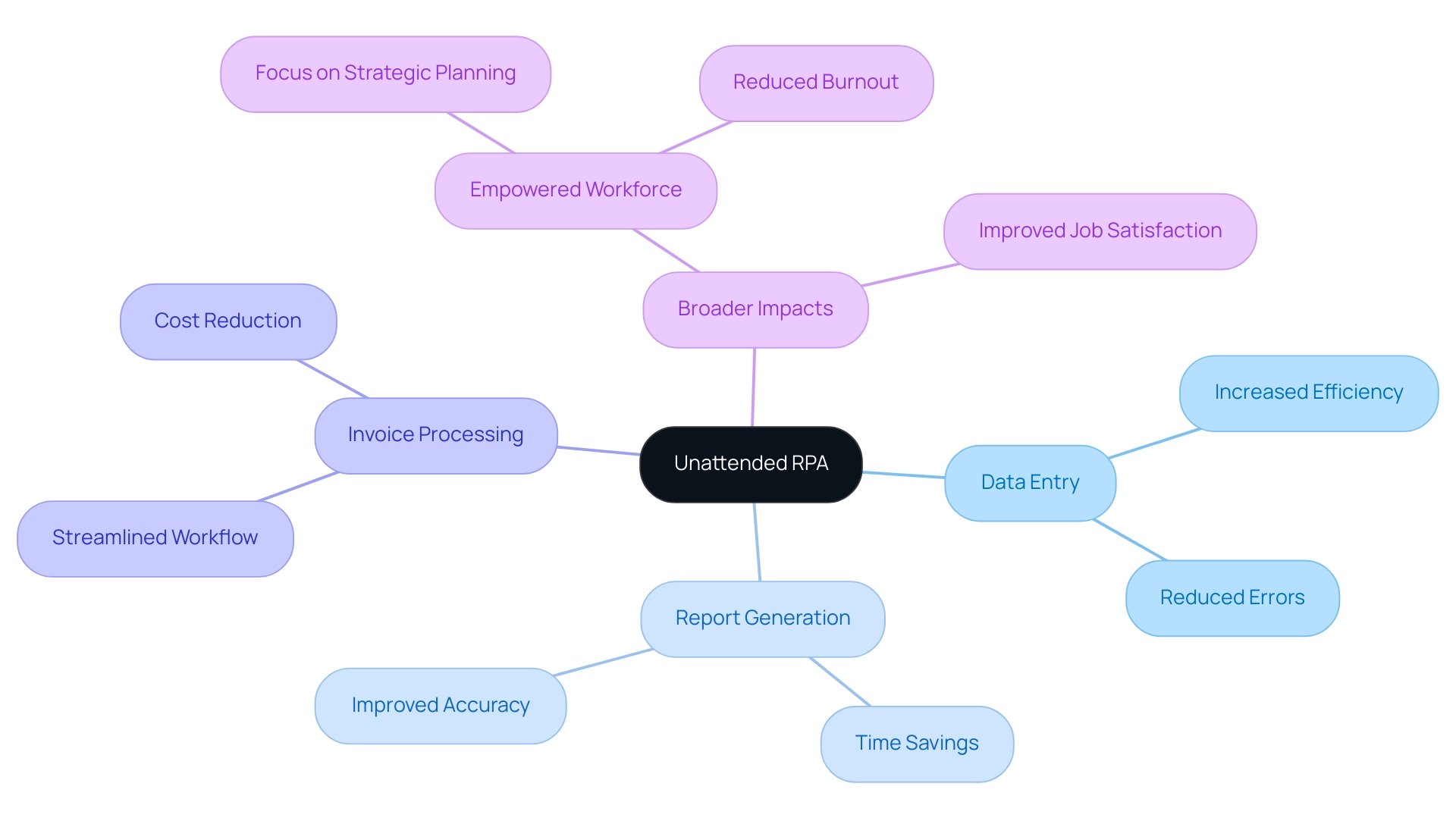Introduction
In the landscape of modern business, where efficiency and adaptability are paramount, unattended Robotic Process Automation (RPA) emerges as a game-changing solution. This innovative technology empowers organizations to automate repetitive tasks autonomously, freeing up valuable human resources for more strategic endeavors.
As companies increasingly seek to enhance their operational efficiency, the benefits of unattended RPA become clear:
- Significant cost savings
- Error reduction
- Improved employee satisfaction
- Continuous availability
By delving into the transformative potential of RPA, businesses can not only streamline their workflows but also position themselves for sustainable growth in an ever-evolving market. Understanding these advancements is essential for leaders aiming to harness technology effectively, ensuring their organizations thrive in a competitive environment.
Understanding Unattended RPA: A Comprehensive Overview
Unattended RPA signifies a major progress in technology, enabling software robots to operate autonomously without human involvement. Unlike attended RPA, which relies on user input, unattended RPA executes predefined workflows autonomously, effectively managing high volumes of tasks around the clock. This capability is particularly advantageous for repetitive and rule-based processes, leading to remarkable enhancements in operational efficiency.
Recent statistics reveal that, on average, workers save an impressive 3.6 hours each week through automated processes, emphasizing RPA’s potential to liberate valuable time for strategic initiatives. Furthermore, 89% of workers report heightened job satisfaction due to automated processes, underscoring RPA’s positive impact on employee morale. By exploring the mechanics of unattended RPA, organizations can unlock transformative potential, streamline workflows, and optimize resource allocation.
The evolution of RPA is shifting from standalone solutions to more comprehensive offerings, including intelligent document processing, enabling greater unattended RPA and accessibility for non-technical users. Key features of EMMA RPA, such as its user-friendly interface and efficiency tools, along with Microsoft Power Automate’s ability to transform operations, exemplify the integration of RPA with artificial intelligence and business intelligence. These advancements not only address staffing shortages and outdated systems but also highlight the ongoing evolution of RPA technology.
For any Director of Operations Efficiency, understanding these developments is crucial for leveraging technology to achieve operational excellence and drive productivity.

Top Benefits of Unattended RPA: Enhancing Efficiency and Productivity
-
Increased Operational Efficiency: Unattended RPA excels at automating repetitive tasks, enabling employees to focus on higher-value activities. Before executing GUI processes, a mid-sized healthcare company faced significant challenges, including manual data entry errors and slow software testing. This shift not only enhances overall productivity but also empowers teams to engage in more strategic initiatives. A case study demonstrated that by automating data entry and software testing, the company achieved a remarkable 70% reduction in data entry errors and an 80% increase in workflow efficiency. Notably, a recent study found that 83% of employees who utilize AI-powered automation believe it significantly reduces burnout while boosting job satisfaction.
-
24/7 Availability: One of the most compelling advantages of unattended RPA is its ability to function continuously without interruptions. Unlike human workers, these automated systems execute processes around the clock, ensuring that critical operations maintain consistency and reliability without any downtime. This constant operation is vital for businesses aiming to enhance service delivery, particularly in sectors like healthcare.
-
By minimizing the potential for human error, unattended RPA contributes to error reduction and enhances the accuracy of data processing and reporting. This decrease in errors not only enhances the quality of output but also fosters trust in automated systems throughout the company. The case study highlighted a significant decrease in manual data entry mistakes, showcasing RPA’s effectiveness in improving operational accuracy.
-
Faster Turnaround Times: The transformational speed at which unattended RPA can complete tasks is remarkable. Processes that once took hours or even days can now be executed in mere minutes. This rapid execution enables companies to respond swiftly to evolving market demands, thereby gaining a competitive edge. In the healthcare case, testing processes were accelerated by 50%, illustrating the time-saving impact of RPA.
-
Enhanced Compliance: Unattended RPA can be configured to adhere to regulatory requirements, ensuring that processes are consistently executed according to the latest standards. This built-in compliance reduces the risk of oversight, enabling entities to navigate complex regulatory landscapes more effectively. As industry groups work on establishing standards for RPA implementations, entities adopting these technologies will find themselves better equipped to foster a reliable and scalable ecosystem for automated processes.
In light of recent news, businesses are encouraged to evaluate which tasks are suitable for attended processes and which workflows can benefit from unattended systems. This consideration is essential for enhancing efficiency and ensuring that organizations utilize RPA effectively, as demonstrated by the success of GUI processes in driving significant improvements in healthcare service delivery. The ROI from implementing these automation solutions was achieved within 6 months, underscoring the financial benefits of RPA.

Streamlining Operations: How Unattended RPA Reduces Manual Tasks
Unattended RPA is revolutionizing operational efficiency by automating routine tasks including:
- Data entry
- Report generation
- Invoice processing
Notably, RPA can manage up to 90% of data entry tasks in clinical research, showcasing its potential to significantly enhance efficiency across various sectors. In finance departments, unattended RPA streamlines account reconciliation, significantly cutting down the time needed for manual checks and reducing errors.
This transition not only accelerates processes but also alleviates the exhaustion caused by repetitive tasks, empowering finance teams to focus on strategic financial planning and analysis. By addressing these burdens, entities can cultivate a more engaged and motivated workforce, thus significantly boosting job satisfaction and overall productivity.
As we address common workplace challenges, such as staffing shortages and outdated systems, the case study titled ‘Cost-Effectiveness of RPA’ illustrates that the advantages of Robotic Process Automation increasingly outweigh the costs of implementation.
Furthermore, tailored AI solutions can enhance decision-making by providing insights that align with specific business goals. Experts agree that the benefits of RPA are becoming a compelling investment for businesses seeking to optimize their operations and navigate the rapidly evolving AI landscape.

Cost Savings Through Automation: The Financial Benefits of Unattended RPA
Implementing unattended RPA can lead to substantial cost savings for companies. By automating repetitive tasks, businesses can significantly lower labor costs linked to manual processing. For instance, companies that automate data entry tasks often report annual savings amounting to thousands of dollars in labor expenses.
Furthermore, the reduction in errors minimizes costs associated with rework and alleviates the financial burden of compliance penalties. Recent studies indicate that entities embracing RPA can expect to see a return on investment (ROI) as high as 300% within the first year of implementation. This compelling data positions unattended RPA as a financially prudent strategy for enhancing operational efficiency and driving overall productivity.
Additionally, as the rapidly evolving AI landscape presents challenges, tailored AI solutions can help businesses identify the right technologies that align with their specific goals. Industry bodies are establishing standards for RPA implementations to ensure best practices and security, which is crucial for organizations considering this technology. As noted by SaltStack, ‘Our investment in automation has yielded financial growth,’ emphasizing the tangible benefits achievable through strategic RPA deployment.
Furthermore, small and medium enterprises (SMEs) are expected to embrace RPA solutions at a growth rate of 25% each year, emphasizing the rising trend and significance of RPA in fostering data-driven insights and efficiency for business growth. Importantly, leveraging Business Intelligence can transform raw data into actionable insights, enabling informed decision-making that further enhances productivity and growth.

Scalability and Flexibility: Adapting Unattended RPA to Business Growth
Unattended RPA is distinguished by its exceptional scalability and flexibility, making it a powerful tool for organizations experiencing growth. Manual, repetitive tasks can significantly hinder efficiency, leading to wasted time and resources. As business demands shift, unattended RPA can be effortlessly scaled to accommodate increased workloads, requiring minimal additional investment.
Notably, Dell has leveraged RPA to boost HR productivity by up to 85%, showcasing its effectiveness in enhancing productivity. Moreover, recent discoveries suggest that 79% of employees credited considerable productivity increases to mechanization, with an average time savings of 3.6 hours per week. This is especially beneficial for sectors with fluctuating demands; for instance, retailers can deploy additional unattended RPA to manage surges in transaction volumes during peak seasons.
Such adaptability not only helps maintain efficiency but also enhances responsiveness to market changes, positioning organizations for sustained success with the use of unattended RPA. Additionally, RPA streamlines workflows by reducing errors and freeing up your team to focus on more strategic, value-adding work.
- 83% of employees using AI-powered automation believe it can reduce burnout and enhance job satisfaction, highlighting the broader implications of RPA on workforce well-being.
As Nick Ostdick, a content developer, succinctly puts it, ‘The flexibility of RPA allows businesses to adapt swiftly to changing needs, ensuring they stay competitive.’ This sentiment reinforces the importance of leveraging RPA alongside tailored AI solutions and Business Intelligence to drive data-driven insights and operational efficiency for business growth.

Conclusion
Unattended Robotic Process Automation (RPA) is transforming the way organizations operate by significantly enhancing efficiency, reducing costs, and improving employee satisfaction. By automating repetitive tasks, businesses can liberate valuable human resources, allowing employees to focus on higher-value activities that drive strategic growth. The evidence is compelling: organizations that implement RPA can achieve remarkable operational efficiencies, with some reporting up to 300% ROI within the first year of deployment.
The benefits of unattended RPA extend beyond mere cost savings. With continuous availability and reduced error rates, companies enjoy enhanced reliability and compliance in their operations. This technology not only accelerates turnaround times but also empowers teams to tackle more complex challenges, ultimately fostering a more engaged workforce. As organizations adapt to the rapidly changing business landscape, the scalability and flexibility of RPA become critical assets, enabling them to respond swiftly to market demands.
In conclusion, embracing unattended RPA is not just a strategic move; it is an essential step towards sustainable operational excellence. By leveraging this innovative technology, organizations can optimize workflows, enhance productivity, and position themselves for long-term success in an increasingly competitive environment. The time to invest in automation is now, as the transformative potential of RPA paves the way for a more efficient, cost-effective, and empowered future.
